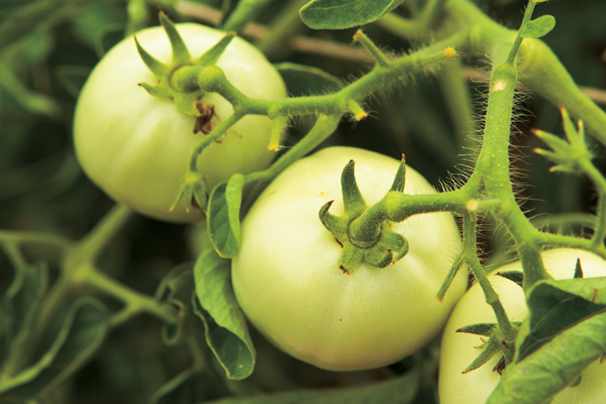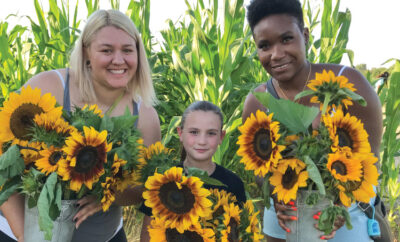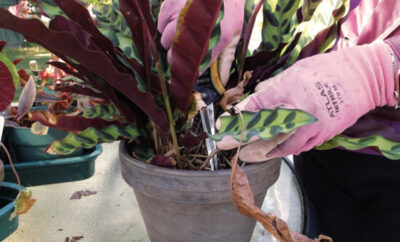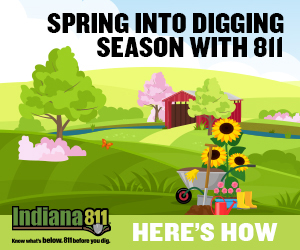Tomatoes are Ripe and Ready for Summer

What compares to the sweet, juicy taste of that first ripe tomato plucked from the vine? It seems to take forever for those little beauties to ripen, but when they do, mouths water in anticipation of this delicious garden morsel.
There are many things to consider when choosing which tomato varieties to grow, though where you grow them doesn’t matter. A standard vegetable garden, a special place in a flowerbed or in containers on a patio require the same care. You might choose to start your tomatoes from seed, which would require planting six weeks before the last frost date in your area. Many forego that notion and purchase their plants from a garden center and transplant them into the ground.
SEE MORE: Farm Facts: Tomatoes
But how do you choose from the myriad varieties? Much depends on what you want to do with your tomatoes. Do you want to eat them fresh on sandwiches or in salads, or do you plan to can them for sauces and salsas? Some varieties are best used for slicing, while more meaty types have fewer seeds, ideal for sauces. Whatever your desire, it’s best to decide what you want before you shop.
Determinate or Indeterminate
Determinate varieties only grow to a certain height, don’t require staking, produce their crops, then are finished. These are best for small gardens. Indeterminate varieties will grow continually until frost takes them down, so they require staking. They have a long season and will produce a large volume of fruit.
Hybrid or Heirloom
Does it really matter? Hybrid plants are combinations of two different varieties, bred selectively for their best attributes, such as taste. Examples of hybrid tomatoes include Early Girl and Celebrity.
Heirlooms, on the other hand, have been passed down through several generations of a family based on characteristics, meaning they’re genetically unique. Cherokee Purple and Brandywine are two types of heirloom tomatoes.
Labels and Looks
You’ll also want to select varieties that are disease resistant. Keep in mind, that is not a guarantee that it’s resistant. On garden shop labels, following the name of the variety, you may see letters such as V (Verticulum wilt), F (Fusarium wilt), N (nematode) or T (tobacco mosaic virus). These labels indicate which varieties are resistant to these conditions.
Tomato plants should be short and stocky-looking with dark green leaves and no blossoms. It takes time for plants to recover from transplant and assume healthy growth. Potted plants in blossom are most likely root bound and stressed. For greater success, choose the right plants in larger pots.
Food and water are necessities of life. Tomatoes need at least 1 inch of water per week. A balanced fertilizer such as 12-12-12 works best when first planted, but once the plant is established, use a tomato-specific fertilizer that’s higher in phosphorus and potassium.
Watching and Waiting
Once they’re planted, it’s just the issue of waiting until they ripen. It’s fun to watch them grow, so make taking a walk in your garden a daily exercise. You’ll see the blooms appear and the fruit develop – and even more important, you can keep an eye out for garden pests, such as the tomato hornworm. This fierce-looking eating machine can consume a whole plant in a couple of days. You’ll first notice missing leaves, then stems, so you need to stop them in their tracks. I usually clip off the offending pest and commit “insecticide” with a firmly planted foot. However, if this muncher is covered with little white cocoons, let it be. It has been parasitized by braconid wasps, which will cause the hornworm to cease to be a pest. The wasp is considered a biological control for several other garden pests.
You’ve waited so long and have given such tender care and attention to your tomato plants, and it’s time to enjoy the fruits of your labor. For the absolute best flavor, harvest your tomatoes when they are firm and fully colored. There’s just nothing like that first juicy bite!
Tomato Recipes
Enjoy your homegrown ‘maters in any of these tasty recipes:
Shaved Country Ham Bruschetta
Italian Tomato Salad
Fresh Ricotta Tomato Salad
Open-Faced Bacon, Tomato and Basil Sandwiches
Summer Succotash
Fried Green Tomatoes
Fresh Tomato Soup
About the Author
Deborah Ashby, a resident of Putnam County, is a Silver Level Advanced Master Gardener and member of the Hendricks County Master Gardener Association. In addition to her passion for gardening, she also owns Premier Imaging, premierimaging.biz, a home-based photography and digital printing business.













 My Indiana Home is produced for Indiana Farm Bureau members. Our mission is to connect you with the food you eat, the Indiana farmers who grow it and a rural lifestyle that is uniquely Hoosier.
My Indiana Home is produced for Indiana Farm Bureau members. Our mission is to connect you with the food you eat, the Indiana farmers who grow it and a rural lifestyle that is uniquely Hoosier.
Leave a Comment